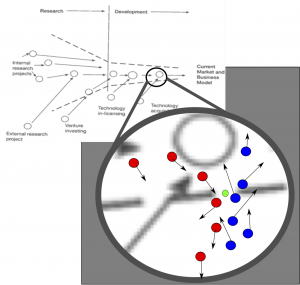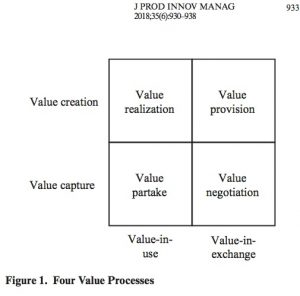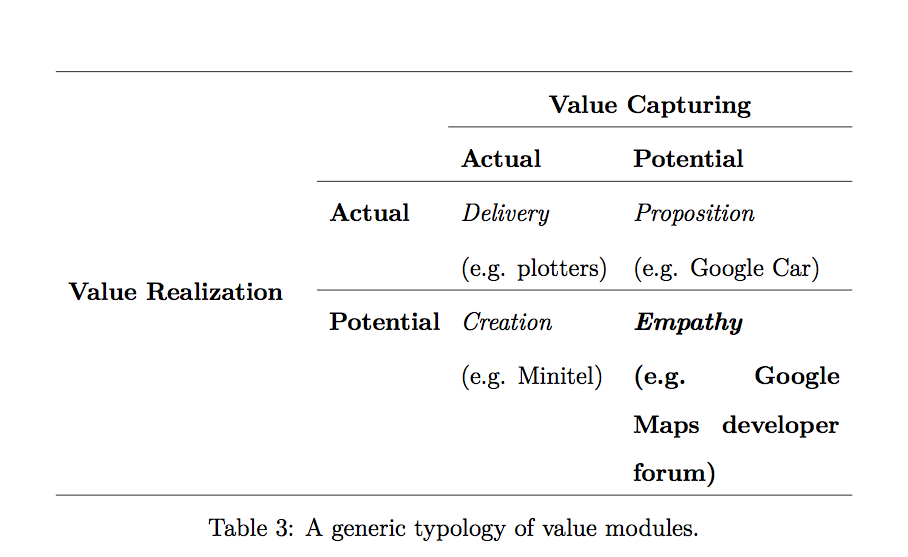A year ago, the Journal of Product Innovation Management (JPIM) launched an open call for studies exploring the following theme: “Value Capture in Open Innovation Systems: Value at the Interface.” Guest-edited by Henry Chesbrough (the founder of the Open Innovation doctrine), Christopher Lettl and Thomas Ritter, the call raised some crucial questions on the appropriation of value, to be answered in a Special Issue (SI).
As it turned out, the Guest Editors eventually replied to their own SI questions by becoming Guest Authors of a “Perspective” article published in the same journal last August. At the same time, the SI itself, initially planed for last November, was canceled and consequently all submitted papers were rejected.
Among others, their published article “inflows” the idea of “value realization” I put forward in the paper I submitted for the SI. However, it fails to inflow my other contribution on the notion of “empathy.” In addition, the authors mingle different concepts, considering that “value realization” is a form of “value creation.”
This blog post retraces the story of the article I had submitted to the projected SI, starting from when I was a Ph.D. candidate at Mines-ParisTech. I hope that this story of my research journey will shed some light on the way the notions of “value creation” and “empathy” ought to be articulated in contemporary innovation processes.
1 The problem: managing innovation on the boundaries of the firm
The call for papers by Chesbrough et al. argued that “focusing on the interface of value creation and value capture urges research designs that study open innovation systems from both a creation and a capture perspective.” In other words, the call admitted a lack of understanding of the possible ways for business to seize innovation occurring on the boundaries of an organization. Thus, Chesbrough et al. were to edit a special issue clarifying at first the relationship between “value creation” and “value capture.” This awareness has been a significant advancement in Management literature per se, as I had also put forward in a paper I had presented in EGOS Conference back in 2015 (Chrysos, 2015b).
For those unfamiliar with the doctrine, Open Innovation is defined as the purposeful inflow and outflow of ideas throughout boundaries of an organization (Chesbrough, 2003). In this framework, the boundaries of an organization are thought as a porous funnel (Bayart et al., 2000). Then, knowledge and ideas are thought like a sort of “sand” that flows through them. Simply put, it is as if the funnel of the New Product Development process used in industry for decades (Wheelwright and Clark, 1992) – separating the company from its environment – had been shot on or turned to a colander, so that knowledge and ideas flow in and out, as illustrated in Figure 1.

Figure 1. A brief review of funnel designs by Management scholars.
Actually, the – still young – discipline of Management Science had often enjoyed the luxury of limiting its scope within the boundaries of a specific organization. Yet, it’s becoming more and more clear that contemporary innovation processes expand beyond the boundaries of a single enterprise, creating and engaging business ecosystems.
This evolution of business fields is also reflected in the relevant literature of the last decades. As Figure 1 illustrates, Wheelwright and Clark (1992) didn’t consider any holes in the organization boundaries, whereas Bayart et al. (2000) identified some tiny ones – merely visible. Chesbrough (2003) on the other hand, made those holes larger.
While most Management scholars operate their research at the level of the enterprises, in my thesis I chosen to focus on these holes at the micro-level, i.e. the interfaces. Using the funnel metaphor, we can thus see the level of my analysis in Figure 2: at the level of the holes there may be knowledge and ideas outflowing (red ones), inflowing (blue ones) or even being born there (green one).

Figure 2: Zooming into Chesbrough’s funnel to see my level of analysis.
So, if the contribution of Chesbrough in relationship to the work of Wheelwright and Clark was to focus on the boundaries of the organization and see that the holes were larger than described by Bayart et al., mine was to focus on these holes. Thus, I could see that beyond simple passages, these holes are also places, from where innovation may emerge. The article I had submitted to the SI and which I presented more recently at the EHESS, further elaborated on this idea (Chrysos, 2018b, 2019b).
2 Turning Interfaces of Web Giants To A Research Field
At a conceptual level, making a Special Issue about value at the interfaces was a good idea.
Besides, innovating with outsiders was the main challenge addressed by my Ph.D. dissertation, defended back in 2013 at Mines-ParisTech (Chrysos, 2013). Back then, many wondered whether the “Web 2.0” would be just another bubble like the dot.com, on the contrary, something that could last more (see for instance Deshayes and Bourguinat, 2008). While most scholars studied it as a communication toolkit, I chose to study it as an emerging industry.
Defining the scope of my research, I argued that “in research fields where the organisational mode includes multiple firms, a central issue (for both practitioners and academics) is the definition of the common boundaries (of the alliance, the venture or the partnership)” (p. 301). In other words, examining knowledge and idea flows requires an understanding of the common “walls,” too.
Still, challenging the funnel model also implied facing methodological challenges: knowing that previous studies in management “were able to limit the scope of their [data] sample through organisational boundaries (be it a specific community or an enterprise), how might we determine the sample of our study in an emerging business environment? ” (p. 92). Put differently, boundaries not only framed the action of an organization, they also used to frame the context of management research and – consequently – the scope of the expected results.
I managed to avoid pre-defined frameworks by opting for an empirical, phenomenon-based approach (Chrysos, 2019a): there existed external developers discussing with Facebook and Google about the technologies of these enterprises and I wanted to study that.
As it turned out, more than simple walls of a funnel, these forums were wide enough to host rich discussions creating knowledge and making emerge ideas. These forums become intimate places (Chrysos, 2011, 2019a), where common preoccupations on the given technologies were shared.
Thus, I was very glad to learn that, six years after my Ph.D. defense, an important management journal launched a call on the topic I’ve been studying for so long!
3 Drawing A Research Path
To be honest, during the first years of my study, I didn’t care much about the gap in the literature. I was just curious to understand the phenomenon: what happens when enterprises like Google and Facebook talk with developers about technological problems? I drew a two-fold research path: analysis/discussion. Thus, I was studying data from these forums while discussing them with scholars and developers in Europe and in the US.
The forum settings used by Google Maps and Facebook were similar to those developed by free software communities (i.e. customized versions of Bugzilla). These settings allow everyone to download the data from the forum discussions. Downloading and examining those data was my starting point.
Yet, as I found out, studying such data is significantly different from standard scientific methods: the researcher has no control on the way the data was created. In a way, their specific nature renders them independent from the researcher’s action, but also independent from scientific knowledge. The researcher is called to understand “what happened”, judging from the “monuments” of past interaction (Chrysos, 2016b, 2017).
While the general ambiance of the times was characterized by an amazement about the technological achievements of those companies, my study revealed an invisible side of the phenomenon: the great majority of issues reported in both Facebook and Google Maps developer forums remained unsolved over a period of six months – no more than 15% of the issues were actually solved!
Personally, I didn’t expect to find such low rates: imagine you have a problem with your phone and that you only have 15% it’s solved within six months…That wouldn’t be serious business!
Moreover, using the same method I found similar problem-solving rates in the forums of two free software projects, the Firefox browser and the Linux OS.
I presented my early findings at the Open and User Innovation Workshop held at the MIT in 2010 and at Mozilla Labs at Mountain View before undertaking a set of interviews with developers of the Silicon Valley.
When I returned in Paris, I had lunch with a friend, a fine Linux developer, at a very nice brasserie. Talking about my findings, he told me about the low problem-solving performance I had found in the forums: “most people reporting bugs are clueless.”
4 Empathy as a Critique to Industrial Expertise
Since then, I spent much of my time interpreting those findings from a managerial perspective. To this end, I focused on the cases of Google Maps and Facebook: many enterprises wanted to become like Google and Facebook so my results could have more value. In addition, enterprises seemed to take management issues more seriously than communities do, thus I was more likely to find answers by studying the two of them.
Unfortunately, literature on Business Models was very poor at the time, so I had to find another literature to discuss with. I took as a reference the most popular book of my supervisor, Armand Hatchuel, “L’expert et le système” (The expert and the system, (Hatchuel and Weil, 1992)).
This book suggests a model for expertise in industrial systems, portraying three categories: the “know-how” of the artisan, the “understanding know-how” of the repairer and the “combining know-how” of the strategist. Each of these categories corresponds to different configurations of enterprise expertise. So, I tried to apply them in my research field.
It turned out, none of them suited me. Thus, I had to criticize them.
As I already mentioned, my data indicated that the greatest part of the issues reported on the forums were just left open during months and discussed like this by the enterprise and the external developers: while every issue raised in the forum expressed a lack of know-how on an aspect of the technologies in question, there was a work to be done before deciding to fix any bugs, or combing proposed features with the strategy of the company. Yet, Management Science had not identified any letting problems unsolved.
By operating a conceptual trick I later on came to call “the epistemological trick with the boxes,” I related my findings to the three known categories of expertise in industrial systems: I had just found a fourth one!
I named the new expertise “empathy” and the corresponding expert a “curator.” Thus, I argued that “before problem solving, a kind of “empathy” between UDEs [i.e. User-Developer-Entrepreneurs] and enterprise needs to be developed”, enabling the curator to take care of issues that cannot be addressed by other experts (Chrysos, 2013, pp. 343-344).
To reach to that conclusion, I had to combine my data findings with my visit at the Silicon Valley. In a manual where a Google employee shared her experience with her fellow Googlers on how to manage developer relations, I found that – beyond the technical advice – showing empathy to external developers facing problems was highly valued.
Despite the critique to his work, my supervisor appreciated this introduction of the notion of empathy in innovation management – his daughter even made a business on that!
And yet, further discussing my results with the management community was not very easy – besides, empathy is not the strongest point of managers. In fact, my paper was “Desk-rejected” (i.e. rejected easily) from the potential editors of the SI mentioned above. But since all submitted papers were eventually rejected, as the Special Issue never got published, I am less frustrated for this rejection than I would initially expect.
Besides, the fact that Chesbrough et al. adhere to the concept of “value realization” I introduced is encouraging, as it shows that I’m in a good path.
5 Value Realization in Open Innovation
I first introduced the concept of Value Realization in 2015, at the EURAM conference that took place in Warsaw, the Open and User Innovation Society Meeting in Lisbon and the EGOS conference that took place in Athens during the same summer (Chrysos, 2015c, 2015a, 2015b). I attended the Lisbon meeting by Skype, as my responsibilities as Vice-President of the Hellenic Organization of Industrial Property obliged me at the time to be in Athens. Still, I managed to Warsaw. There, as one could tell by the look in the eyes of the participants of the EURAM conference that attended my presentation, I understood that there was still work to be done to clarify what this concept was all about. To this end, the EGOS conference in Athens was very helpful, the distinction between “value capture” and “value realization” was much appreciated.
Thus, in the paper I submitted to the JPIM special issue, I rendered the distinction between “the resources, the competencies and the lineages of products an enterprise can already develop” and “those that an enterprise could develop in the future” (Chrysos, 2018b, p. 7) more explicit.
While Chesbrough et al in their rejection letter told me that “Some of the definitions are confusing”, it was nice to see they ended up by adhering to the concept of value realization while editing their own paper.
When I was younger, I had bought the book “Open Business Models” by Chesbrough. There, I read the “Functions of A Business Model” (p. 109) and I found it very messy: the book was confounding the notions of value proposition and value creation and it used many complex words such as “value chain”, “value network” and “structure” without really explaining them. The term “value realization”, however, didn’t figure among the “Functions of a Business Model.” Recently, I took another look at the book to discover that the term is used on page 100 in a very reserved way, while talking about something else.
In their new paper, Chesbrough et al mark a significant progress. First, they don’t refer at all to the complex terms or the “Functions” mentioned above. Secondly, they adhere – in a less reserved way – to the term of value realization.
Science is not only about introducing terms. It’s also about understanding the relationship among them. For instance, in a paper I published in the journal Natures, Sciences et Sociétés I discuss about contemporary epistemology based on a paper of Albert Einstein. There, Einstein shows that Physics Theories have been developed from Newton to the Theory of Relativity by suggesting different configurations between the notions of “ether” and “matter” (Chrysos, 2016a).
Thus, in their recent paper, Chesbrough et al advance their understanding of value realization, trying to find out its relationship with value creation. In Figure 3, you can find the 2×2 matrix which illustrates their progress.

Figure 3: The 2×2 matrix of Chesbrough et al. (2018).
Figure 3: The 2×2 matrix of Chesbrough et al. (2018).
The matrix reveals that, as we speak, they apparently consider value realization as a form of value creation. However, as I explain in my recent paper – briefly summarized bellow – it’s the other way around. Still, to understand this relationship, one has to introduce the other term, previously unknown in the literature of business models: empathy.
6 Value Realization on the Boundaries of Open Innovation
In my recent paper Empathy in the business model: how Facebook and Google Maps manage external problem-solving processes (Chrysos, 2018a), I explain the interplay of different forms of value. In Figure 4, you can find my 2×2 matrix, while the paper is openly accessible.

Figure 4: The 2×2 I propose in my paper (Chrysos, 2018a).
To make this matrix, I introduced the axiom of Value Realization – Value Capture Distance. According to this axiom, value is only delivered when Realization and Capture are met. In other words, value realization can, in fact, coincide with value creation. Yet, it can also take other forms (i.e. delivery, proposition or empathy). Its form depends on whether or not we are talking about the present or the future, as well as whether or not we actually have the corresponding mechanism to capture this value. If not, we’re limited to the formulation of propositions or the expression of empathy.
Once we thus clarify the term of Value Realization, we can then get more clear, as well, concerning standard forms of value. In the introduction of the paper, I provide an empirical illustration of the different forms value can take in the context of technological development :
• Value Delivery refers to the actual delivery of the technology to the client. For instance, think about some new plotters being delivered at the local offices of a client active in the design business. In this case, the value actually realized is also actually captured by the successful selling of the plotters.
• Value Proposition refers to the technologies that are potentially available by the enterprise, without being sure of the capacity of the enterprise to actually create or deliver this value. For instance, think about the Google Car: it is a well known project, but no-one can actually buy it. In such a case, we talk about a value proposition from a research project, a prototype or a concept car which actually captures a value, while the realization remains potential insofar it hasn’t been turned into a product or a service.
• Value Creation refers to the actual creation of the technologies the enterprise proposes to a market. Still, not all the technologies are sold. For instance, think about the enterprises manufacturing terminals for the Minitel, the French data communication network preceding the Web, when the Internet started spreading in France during the late 90’s. In this case, the potential capturing of the value actually realized by the Minitel manufacturer depended on the market share of the Internet.
Empathy emerges as a new form of value, I initially observed in the specific context of the developer support forums. Provided one doesn’t know what fixing a bug reported in a forum is worth, showing empathy is the best thing to do.
7 Back to Communities
It turns out, these findings are also in-line with the experience of Linus Torvalds, the famous leader of the Linux project. As Torvalds recently wrote to the Linux community, he decided to “take some time off” to “get some assistance on how to understand people’s emotions and respond appropriately.” After courageously admitting that he’s “not an emotionally empathetic kind of person” he also acknowledged that he “misread people” failing to understand “how badly” he had “judged a situation and contributed to an unprofessional environment.”
Thus, beyond enterprises, clarifying the place empathy ought to have in innovation processes is also relevant for communities.
So, I guess I should also tell to my Linux developer friend to be more understanding and patient with other developers reporting bugs in the code!
Paris Chrysos
References
Bayart, D., Bonhomme, Y., and Midler, C. (2000). Management Tools for RetD Project Portfolios in Complex Organizations – the case of an international pharmaceutical firm. In Benghozi, P.-J., Charue-Duboc, F., and Midler, C., editors, Innovation Based Competition et Design Systems Dynamic, pages 135–158. L’Harmattan, Paris, France.
Chesbrough, H., Lettl, C., and Ritter, T. (2018). Value creation and value capture in open innovation. Journal of Product Innovation Management, 35(6):930–938.
Chesbrough, H. W. (2003). Open Innovation: The New Imperative for Creating And Profiting from Technology. Harvard Business Press, Boston, Mass., first trad edition.
Chrysos, P. (2011). An organisational design approach of business environments: the case of Barcamps milieu in Paris. International Journal of Organisational Design and Engineering, 1(4):315 – 330.
Chrysos, P. (2013). When users create industries: the case of Web-based applications. PhD thesis, Mines-ParisTech.
Chrysos, P. (2015a). From problem-solving to value care: the business logic of online support forums. In 13th Open and User Innovation Conference, Lisbon, Portugal.
Chrysos, P. (2015b). Value care : the modular emergence of value in the Web. In EGOS, page 19, Athens, Greece.
Chrysos, P. (2015c). VALUE CARE: MANAGING THE EMERGING. THE CASE OF DEVELOPER SUPPORT FORUMS. In EURAM Conference, page 30, Warsaw, Poland.
Chrysos, P. (2016a). Autour des travaux d’Anne-Françoise Schmid : le potentiel scientifique d’un courant épistémologique. Natures Sciences Sociétés, 24.
Chrysos, P. (2016b). Monuments of cyberspace: Designing the Internet beyond the network framework. First Monday, 21(12).
Chrysos, P. (2017). Between disciplines and experience: Understanding Big Data as “monuments of cyberspace”. In Karandinou, A., editor, Between Data and Senses; Architecture, Neuroscience and the Digital Worlds, pages 66–68, London. UEL.
Chrysos, P. (2018a). Empathy in the business model: how Facebook and Google Maps manage external problem-solving processes.
Chrysos, P. (2018b). Where is the problem? Bridging the gap between value capturing and value realization in open innovation processes. Submitted to JPIM SI.
Chrysos, P. (2019a). Au delà des institutions : l’intimité collective à l’origine de l’émergence industrielle. In Chrysos, P. and Gentes, A., editors, L’aventure épistémologique contemporaine. Kimé, Paris.
Chrysos, P. (2019b). L’empathie cognitive et relationnelle. In Dagnaud, M. and Alexandre, O., editors, Seminaire Le Modèle Californien, EHESS, Paris.
Deshayes, C. and Bourguinat, E. (2008). Faut-il prendre au sérieux le web 2.0 ?
Hatchuel, A. and Weil, B. (1992). L’expert et le système: gestion des savoirs et métamorphose des acteurs dans l’entreprise industrielle, suivi de quatre histoires de systèmes-experts. Economica.
Wheelwright, S. C. and Clark, K. B. (1992). Revolutionizing Product Development: Quantum Leaps in Speed, Efficiency, and Quality. Free Press.
